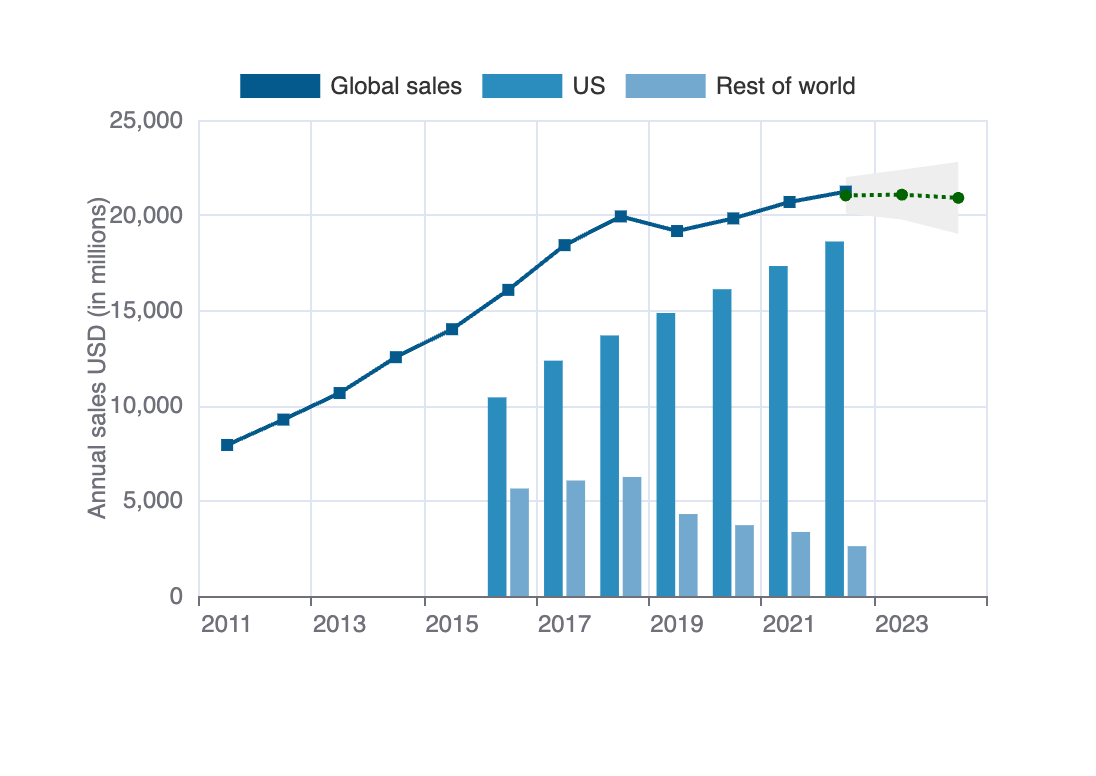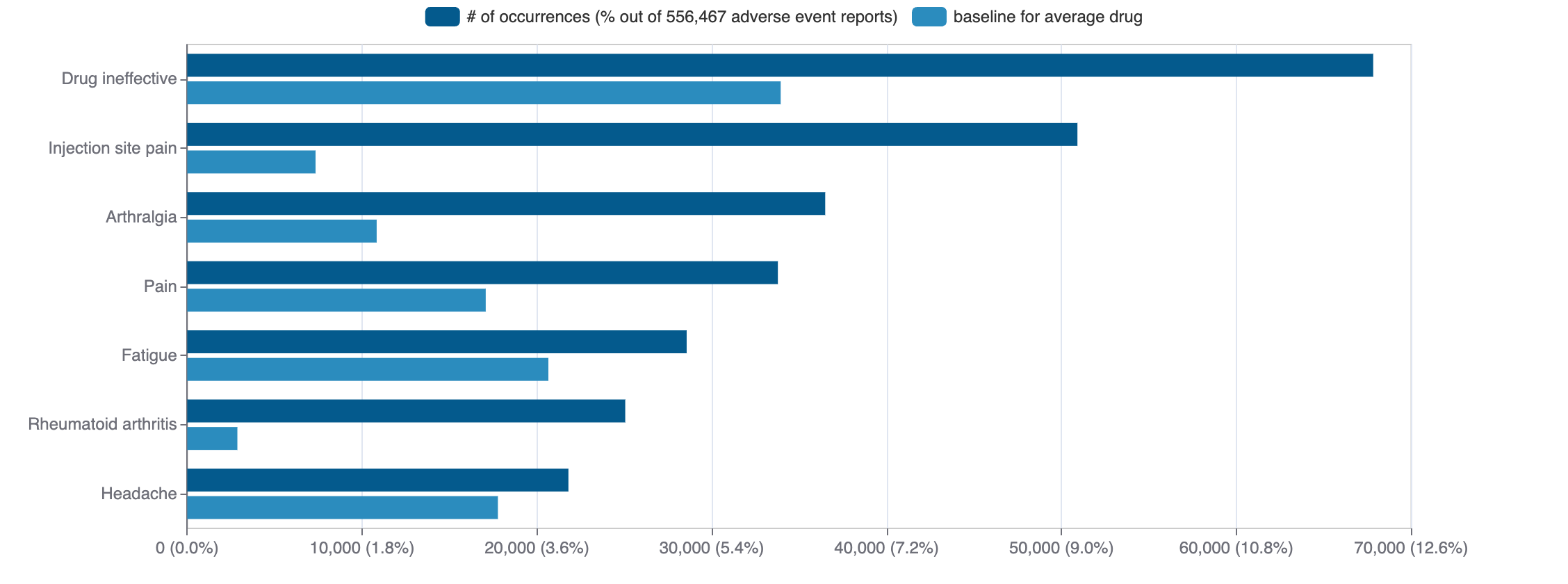Exelon(rivastigmine)
Exelon, Prometax (rivastigmine) is a small molecule pharmaceutical. Rivastigmine was first approved as Exelon on 1998-05-11. It is used to treat alzheimer disease in the USA. It has been approved in Europe to treat alzheimer disease, dementia, and parkinson disease. The pharmaceutical is active against cholinesterase and acetylcholinesterase.
Download report
Favorite
Commercial
Trade Name
FDA
EMA
Exelon (generic drugs available since 2007-10-22, discontinued: Exelon)
Drug Products
FDA
EMA
New Drug Application (NDA)
New Drug Application (NDA)
Abbreviated New Drug Application (ANDA)
Abbreviated New Drug Application (ANDA)
Labels
FDA
EMA
Brand Name | Status | Last Update |
|---|---|---|
| exelon | New Drug Application | 2020-12-15 |
| rivastigmine transdermal system | ANDA | 2023-02-24 |
Indications
FDA
EMA
Indication | Ontology | MeSH | ICD-10 |
|---|---|---|---|
| alzheimer disease | EFO_0000249 | D000544 | F03 |
Agency Specific
FDA
EMA
No data
Patent Expiration
No data
HCPCS
No data
Clinical
Clinical Trials
82 clinical trials
View more details

Mock data
Subscribe for the real data
Subscribe for the real data
Indications Phases 4
Indication | MeSH | Ontology | ICD-10 | Ph 1 | Ph 2 | Ph 3 | Ph 4 | Other | Total |
|---|---|---|---|---|---|---|---|---|---|
| Alzheimer disease | D000544 | EFO_0000249 | F03 | 1 | 1 | 9 | 18 | 5 | 34 |
| Parkinson disease | D010300 | EFO_0002508 | G20 | — | — | 3 | 5 | — | 8 |
| Delirium | D003693 | R41.0 | 1 | 1 | 3 | 3 | — | 7 | |
| Healthy volunteers/patients | — | 2 | — | — | 2 | 1 | 5 | ||
| Cognitive dysfunction | D060825 | G31.84 | — | — | 1 | 3 | 1 | 5 | |
| Traumatic brain injuries | D000070642 | S06 | — | — | 2 | 1 | — | 3 | |
| Multiple sclerosis | D009103 | EFO_0003885 | G35 | — | — | — | 1 | — | 1 |
| Postoperative cognitive complications | D000079690 | — | — | — | 1 | — | 1 | ||
| Stroke | D020521 | EFO_0000712 | I63.9 | — | — | — | 1 | — | 1 |
| Hiv infections | D015658 | EFO_0000764 | B20 | — | — | — | 1 | — | 1 |
Indications Phases 3
Indication | MeSH | Ontology | ICD-10 | Ph 1 | Ph 2 | Ph 3 | Ph 4 | Other | Total |
|---|---|---|---|---|---|---|---|---|---|
| Dementia | D003704 | F03 | — | 1 | 2 | — | 1 | 4 | |
| Progressive supranuclear palsy | D013494 | EFO_0002512 | G23.1 | — | 1 | 1 | — | — | 2 |
| Vascular dementia | D015140 | F01 | — | — | 2 | — | — | 2 | |
| Psychophysiologic disorders | D011602 | F45.9 | — | — | 1 | — | — | 1 | |
| Schizophrenia | D012559 | EFO_0000692 | F20 | — | — | 1 | — | — | 1 |
| Depression | D003863 | F33.9 | — | — | 1 | — | — | 1 | |
| Anxiety disorders | D001008 | EFO_0006788 | F41.1 | — | — | 1 | — | — | 1 |
| Neurobehavioral manifestations | D019954 | EFO_0004364 | — | — | 1 | — | — | 1 | |
| Cognition disorders | D003072 | — | — | 1 | — | — | 1 | ||
| Apathy | D057565 | — | — | 1 | — | — | 1 |
Indications Phases 2
Indication | MeSH | Ontology | ICD-10 | Ph 1 | Ph 2 | Ph 3 | Ph 4 | Other | Total |
|---|---|---|---|---|---|---|---|---|---|
| Down syndrome | D004314 | EFO_0001064 | Q90 | 1 | 1 | — | — | 1 | 2 |
Indications Phases 1
Indication | MeSH | Ontology | ICD-10 | Ph 1 | Ph 2 | Ph 3 | Ph 4 | Other | Total |
|---|---|---|---|---|---|---|---|---|---|
| Substance-related disorders | D019966 | EFO_0003890 | F13 | 3 | — | — | — | — | 3 |
| Therapeutic equivalency | D013810 | 2 | — | — | — | — | 2 | ||
| Pure autonomic failure | D054970 | 1 | — | — | — | — | 1 | ||
| Orthostatic hypotension | D007024 | I95.1 | 1 | — | — | — | — | 1 | |
| Biological availability | D001682 | 1 | — | — | — | — | 1 | ||
| Cocaine-related disorders | D019970 | F14 | 1 | — | — | — | — | 1 | |
| Central nervous system diseases | D002493 | HP_0002011 | G96.9 | 1 | — | — | — | — | 1 |
| Hallucinations | D006212 | HP_0000738 | F06.0 | 1 | — | — | — | — | 1 |
| Psychotic disorders | D011618 | F20.81 | 1 | — | — | — | — | 1 |
Indications Without Phase
Indication | MeSH | Ontology | ICD-10 | Ph 1 | Ph 2 | Ph 3 | Ph 4 | Other | Total |
|---|---|---|---|---|---|---|---|---|---|
| Lewy body disease | D020961 | EFO_0006792 | G31.83 | — | — | — | — | 1 | 1 |
Epidemiology
Epidemiological information for investigational and approved indications
View more details
Drug
General
| Drug common name | RIVASTIGMINE |
| INN | rivastigmine |
| Description | Rivastigmine is a carbamate ester obtained by formal condensation of the carboxy group of ethyl(methyl)carbamic acid with the phenolic OH group of 3-[(1S)-1-(dimethylamino)ethyl]phenol. A reversible cholinesterase inhibitor. It has a role as an EC 3.1.1.8 (cholinesterase) inhibitor, a neuroprotective agent and a cholinergic drug. It is a carbamate ester and a tertiary amino compound. It is a conjugate base of a rivastigmine(1+). |
| Classification | Small molecule |
| Drug class | cholinesterase inhibitors (physostigmine type) |
| Image (chem structure or protein) | |
| Structure (InChI/SMILES or Protein Sequence) | CCN(C)C(=O)Oc1cccc([C@H](C)N(C)C)c1 |
Identifiers
| PDB | — |
| CAS-ID | 123441-03-2 |
| RxCUI | 183379 |
| ChEMBL ID | CHEMBL636 |
| ChEBI ID | 8874 |
| PubChem CID | 77991 |
| DrugBank | DB00989 |
| UNII ID | PKI06M3IW0 (ChemIDplus, GSRS) |
Target
Agency Approved
BCHE
BCHE
ACHE
ACHE
Organism
Homo sapiens
Gene name
BCHE
Gene synonyms
CHE1
NCBI Gene ID
Protein name
cholinesterase
Protein synonyms
Acylcholine acylhydrolase, Butyrylcholine esterase, Choline esterase II, cholinesterase (serum) 2, cholinesterase 1, Pseudocholinesterase
Uniprot ID
Mouse ortholog
Bche (12038)
cholinesterase (Q543J3)
Alternate
No data
Variants
Clinical Variant
No data
Financial
Exelon - Novartis
$
€
£
₣

Mock data
Subscribe for the real data
Subscribe for the real data

Mock data
Subscribe for the real data
Subscribe for the real data
Tabular view
Trends
PubMed Central
Top Terms for Disease or Syndrome:

Mock data
Subscribe for the real data
Subscribe for the real data
Additional graphs summarizing 7,966 documents
View more details
Safety
Black-box Warning
No Black-box warning
Adverse Events
Top Adverse Reactions

Mock data
Subscribe for the real data
Subscribe for the real data
132,139 adverse events reported
View more details
Premium feature
Learn more about premium features at pharmakb.com
Learn more
